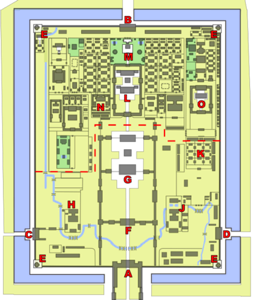Peter Szolovits’ Blog
2010

During my visit to China, I had about a day and a half to play tourist. One day at the beginning of my visit, which I had officially set aside to fight the 12 hours of jet lag between Boston and Beijing, and a half-day between returning from Changsha and embarking on my flight back to the US. (The day to get over jet lag was way too little!) On my first day in Beijing, three of us had arranged a tour to see the Great Wall and the Summer Palace, two of the "must see" sights of Beijing.
The Summer Palace
Our tour guide met us around 7:30am, and he and his minibus driver took us around for the day. We first drove to the Summer Palace, which is a rather late set of much older style Imperial buildings dating from the late 19th and early 20th centuries, where the hand of the dowager and regent Cixi shows paramount. The old Summer Palace, which was on a nearby but different plot of land, was razed in the Opium Wars by some British general, who thought that doing so would "bring some sense" to the emperor. That site remains today in a destroyed state, reminding the Chinese how bad it can be to be powerless against the outside world. The place we visited was actually built in the 18th century and it, too, was burned in the opium wars and the Boxer rebellion, but then rebuilt under Cixi’s rule. She is said to have embezzled about thirty-six million troy ounces of silver for the reconstruction, which had been set aside to build the Chinese Imperial Navy instead. This later proved catastrophic in wars against Japan, which did invest in a modern navy, whereas China was left defenseless.
The Summer Palace is built along the edges of a huge man-made lake, a beautiful sight, and a setting for an island with its own shrine, bridges, and dragon boats. The palace buildings are in the Imperial Chinese style, with curved tile roofs and brightly painted wooden beams. Many statues of mythical beasts, great bronze vessels, and huge philosopher stones populate the grounds. The long gallery, a spectacular covered walk taking a sinuous course next to a row of trees, looking out on the lake on one side and a tranquil pool on the other, is one of the Palace’s great features. It’s in the photo above. I’ve enjoyed the Huntington’s recent construction of a Chinese Garden in San Marino, California; this park has many of the features they are surely trying to emulate, on a much smaller scale.
Another of Cixi’s great follies is a marble boat, cut from a single giant block of marble, serving as an outdoor place to entertain. It combines a Western architectural style, the form of a dragon boat, and the total immobility of a giant block of rock. My photo on the right, taken by our tour guide, shows its rather garish form, as well as my burden of photo gear.
The Great Wall at Badaling
Contrary to my preconception, the Great Wall is in the extended suburbs of Beijing, not anywhere near the actual present border of China. It’s also not a single continuous wall stretching across northern China to protect against invasions, but instead a series of lengthy segments meant to protect certain approaches to Beijing and northern China. Trenches and impassable mountains, together with the segments of wall, form a 5,000+ mile barrier, parts of which are 2,500 years old, but most of which date to the Ming dynasty. We, as do most tourists to Beijing, went to Badaling, one of the more easily accessible parts of the Wall, and one that has been sufficiently restored that it can safely handle the vast horde of tourists who visit. After strolling along the top for about an hour, I reached a section where the way was barred, and I was told that the sections beyond where I was were not restored, and thus crumbling and dangerous. This did not inhibit a number of native Chinese from climbing over the barrier to continue their explorations, but the danger, the manifestly obvious video camera taking in the scene, and a need to return to my tour dissuaded me.
The Wall is massive. At the section I visited, it is about 25 feet tall, 16 feet wide, and runs sinuously along the ridge of rather rugged hills. Facing outward, it is lined with a continuous wall arrayed with excellent places from which to shoot arrows downward at any troops brave enough to endure the fire as they have to climb up a mountain side just to get to the base of the wall, and then find a way to climb up to the top. There are also periodic turrets, which provide higher and more protected firing places. The wall is made of solid brick and stones, and there is no ground near it from which to mount a charge with a battering ram, so I think before the era of gunpowder (used as a weapon, not for fireworks), it would have been close to impregnable. The wall curves not only from side to side but also up and down as it follows the ridge line.
I was expecting to see and photograph a scene much like the one to the right (a standard publicity photo), or the beautiful shots of President Obama recently visiting, with the Great Wall stretching off to infinity behind him on a radiant, clear day. Alas, we were there in the fog, which was mysterious and magical, but where infinity started at about 50 to 100 feet. Even pictures of people near me look really hazy. Although not this intense, I experienced the same kind of fog throughout my stay in Beijing. Fortunately, it seemed due to natural humidity in the air, not the tremendous pollution for which the city is famous. My Chinese students assure me that before the cleanup for the Olympics last year, it would have been smog.
I suppose this is quite uncommon along other sections of the Wall, but we ascended to the foot of the Great Wall by riding a clunky amusement park ride at a park known mainly for the variety of captive bears that it exhibits. What looks like it may have been built as a thrill ride pulls its cars up the hill, where one can get off at the foot of the Wall. On returning, you get back on the car, which is tethered to a chain of others, and you rush down a track back to the bottom. A “driver” sits in front, which is a special car where he brakes to impede the momentum of your chain, reducing the thrill to a tepid ride, but one that probably suits most visitors.
Obligatory visits to a restaurant serving Peking Duck, a jade shop, and silk store rounded out the rest of our tourist day. Much of the jade is beautifully worked, but the appealing large pieces can be tens of thousands of US dollars, so I had no trouble resisting. The silk appealed to one of my (female) colleagues, but I own more than enough ties, and a silk jacket might have seemed pretentious on a Westerner.
The Forbidden City
During my last half-day in Beijing, I just had to visit the Forbidden City. It is a vast walled city that was the exclusive province of the Imperial family and government for five centuries. The layout is rectangular, with a main axis running from Tien An Men Square on the south to a relatively less imposing gate (the Gate of Divine Might) returning to a park and the center of the modern city at the north. Ignoring minor matters like architecture, history and location, it reminded me greatly of the Topkapi Palace in Istanbul in its formal organization. The main axis, running from south to north, takes one through a successive series of gates, pavilions and courtyards, which become more exclusive the further in you go. The innermost courtyard is the Emperor’s garden, which provided privacy and a kind of formal relaxation. Topkapi has the same structure, though there the garden is at the point of land where the Bosporus and the Golden Horn meet, giving more spectacular views than those available in the middle of a relatively flat Beijing.
Walking north under the huge picture of Mao at the Tien An Men gate, you enter a front courtyard, full of vendors selling postcards, digital memory cards, and soft drinks. Every third person is a student offering to guide you through the Palace for a pittance. (I suddenly developed language amnesia and could speak only Hungarian, until I actually ran into a Hungarian tour guide!) You enter the Forbidden City itself through the Meridian Gate (A on the diagram), a formidable and easily defended U-shaped structure that is clearly meant to impress with its immensity and severity. This is where passage to those without court business was “forbidden”.
The first courtyard is the one I always think of as representing the Forbidden City because of its iconic stream with the five parallel stone bridges that usually provides a backdrop to guards marching or foreign dignitaries entering. It is immense and imposing, between the back of the Meridian Gate and the Gate of Supreme Harmony (Tai He Men), which was the outer border of where the Emperor would receive reports from functionaries or issue decrees. The square is also bordered by impressive gates on the east and west sides, leading to military and literary portions of the Forbidden City. Two bronze lions represent the Empress and Emperor. The female has her paw on a cub, who squirms on his back; the male has his paw on an orb, representing his rule. In fact, many depictions of rulers show the male and female in some mythical representation. At the Summer Palace, we saw pairs of Phoenix and Dragons representing the Empress and Emperor.
The golden tiles of all the buildings glisten in the afternoon sun. When illuminated directly, such as the gate and gallery on the left, below, they glow. When backlit, on the right, their highlights shimmer. Truly a magnificent scene, for which this small panorama cannot do real justice.
Playing Tourist in Beijing
6/26/10
During my June 2010 trip to China, I visited the Summer Palace, the Great Wall, and the Forbidden City during my limited tourist time. These are my pleasant memories.
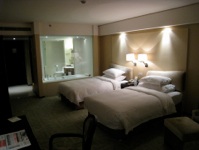
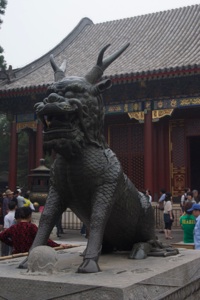

Imperial qilin before a palace building
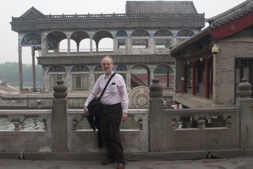
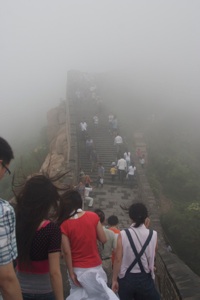
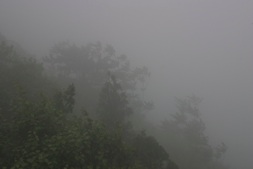

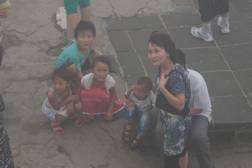
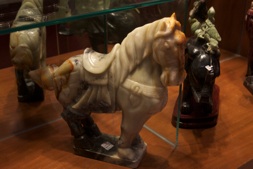

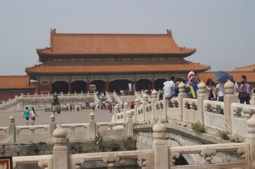
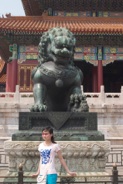
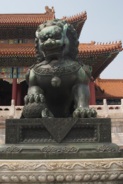

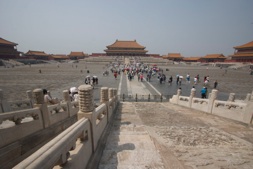
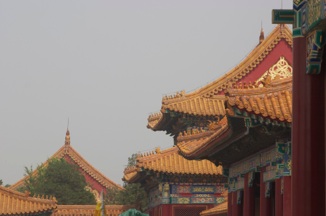
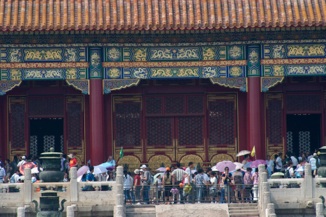
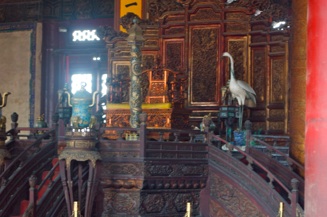
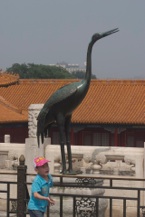
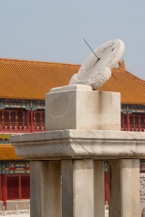
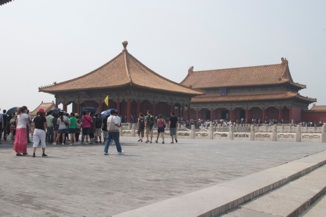
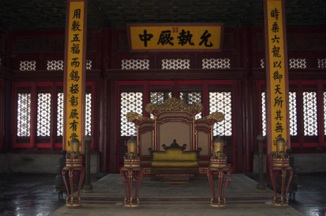

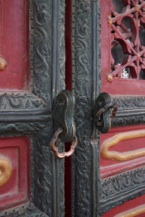
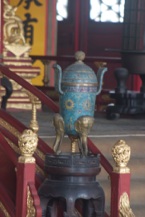
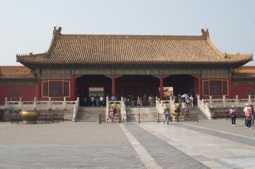
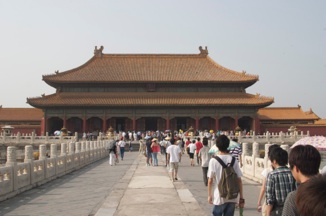

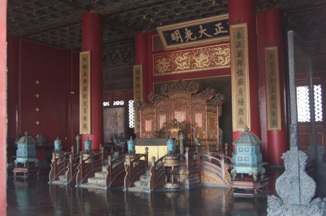
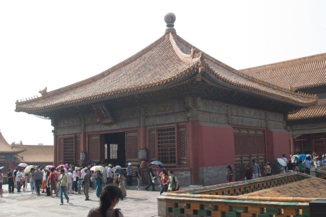
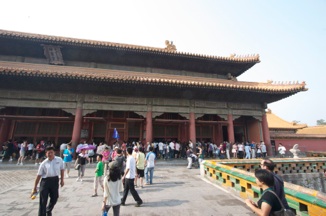
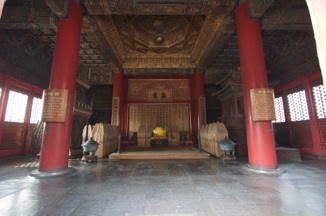
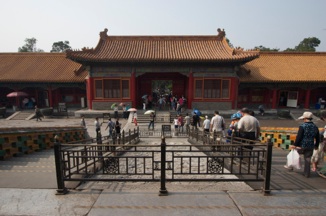
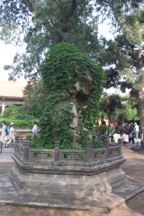
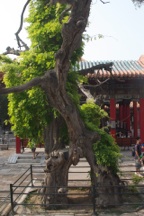


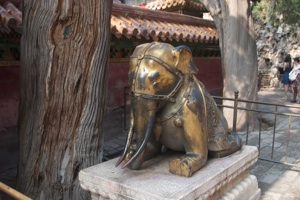

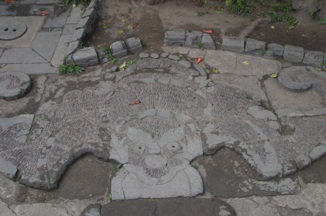
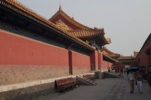
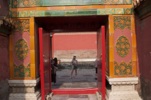

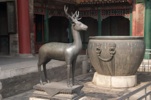
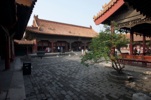
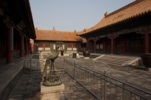


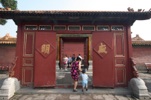
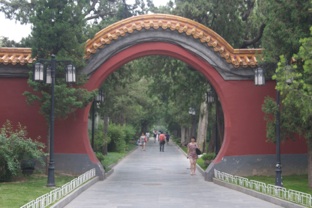
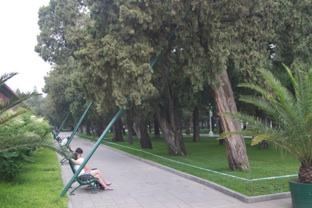
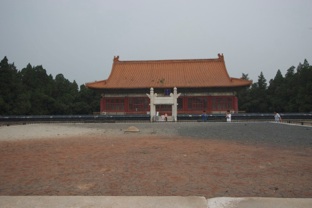
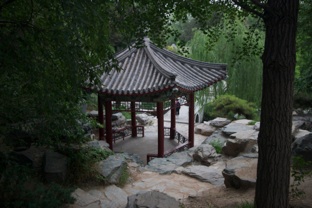


Altogether, a fascinating, spectacular, and tiring day and a half in Beijing. I must return sometime for a deeper, broader, and more intense study.
I ended my day in the Forbidden City by walking around the Zhongshang Park, an old Buddhist monastery now dedicated to the memory of Sun Yat Sen. It contains the Altar to the Gods of Land and Grain, where the Emperor would pray yearly for a good harvest on a field divided by colored soils into a central, north, east, south and west quadrant. The park also contains the Laijin Yuxuan restaurant, which serves authentic old fashioned Buddhist vegetarian meals. I would have tried it, but found it closed.
Having traversed the main axis, I then strolled into the west side of the Forbidden City, which served as the residence of the empress and concubines, and held countless little courtyards devoted to education, the arts, and treasures. The scale here is more intimate and charming, and the tiles, plants and wooden details are quite beautiful. But the many severe walls, gates with strong logs to bar them shut, and long alleyways where an attacker could be trapped in a deadly ambush remind me of the fear of instability and the definite defensive role of the Palace grounds.
The inner sanctum of the Forbidden City was the Imperial Garden (Yu Hua Yuan), where the emperors and their empresses and concubines strolled, and where future harem members were chosen. The garden is quite formal and symmetric in structure, but contains rocks, gnarled plants, and mandrake-shaped trees to bring to it a sense of wilderness. It is also full of little pavilions and architectural features to provide pleasant places to loll about and to interest the eyes. The Gate of Divine Might (Shen Wu Men) leads out to Jinshang park and the city beyond.
Beyond the Gate of Heavenly Purity (Qian Qing Men, on the right) is the inner, residential part of the palace, with a further succession of halls that serve as the residence of the emperor, empress and court. The Palace of Heavenly Purity (Qian Qing Gong) was the emperor’s residence, and held a notable box into which the ruler would deposit the name of his appointed successor, whose identity would only be revealed on the Emperor’s death. The Hall of Earthly Tranquility (Kun Ning Gong) served as the Empress’ residence, thus giving the couple the rule of everything from heaven to earth. Between these is the small Hall of Union and Peace (Jiao Tai Dian), furnished and used for family ceremonies. The name suggests possible other activities that are not publicly commented on.
The next courtyard, another imposing place with complex tiered terraces, leads to the smaller Hall of Central Harmony (Zhong He Dian) in the center and the larger Hall of Preserved Harmony (Bao He Dian). “Central” served as a kind of vestry for the Emperor preparing for his official functions. “Preserved” had served at various times in history as a residence, banquet hall, wedding site, and examination room.
The next courtyard leads to the Hall of Supreme Harmony (Tai He Dian). The photo on the right shows a stone carved ramp flanked by stairs from the rear of Tai He Men, a vast courtyard, then leading up a tiered series of terraces to this imposing Hall. Here some Emperors and Empresses were enthroned, celebrations were held for major holidays, new civil servants were announced, and generals were sent out to war. I see the Hall as very colorful and even garish, but I’m continually enchanted by the texture, lines and colors of the tile roofs. In the second row, below, are the throne, and a bird (crane?) and sundial, attesting to the power of the Emperor.
